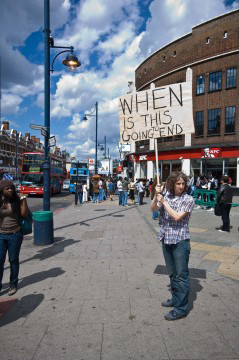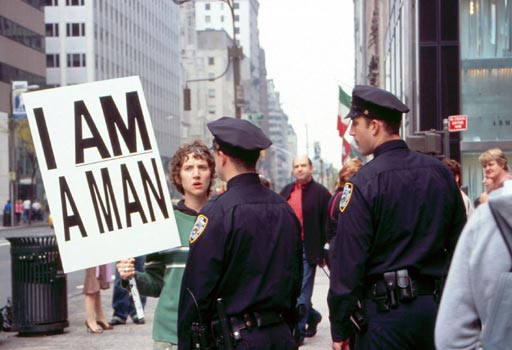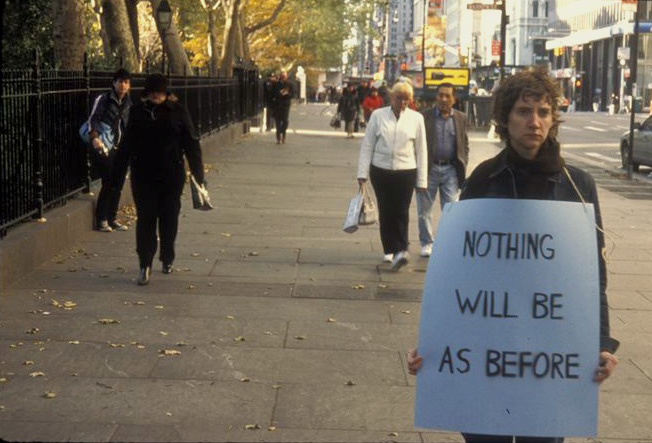“There is no such thing as coincidence. Only opportunity tempered by experience and fueled by ambition.” ( napier) A selective engagement with irrationality.A narrative of private woe and anguish inserted into the impersonal environment.They appear as neither statement nor question. In the context of amplified religious instruction and urban noise they could be taken as nihilistic mantra or slogan expressing a repulsion of the commercial din.
These historical speeches, and Hayes’s work in general, explore the construction of gender and sexuality and the articulations of political protest, revealing resonances over time periods. These types of chance juxtapositions of disparate images and content are cause for some hope; a little color and verve on the bleak landscape that is not in the service of selling some dumb product or service. Our individual intelligence is the ultimate editing and montage device. Sharon Hayes work encourages the viewer to realize how past forms of protest can inform the present and how effects of public speech are altered in the process of documentation.The control of history is the control of identity and the same cultural washing is repeated in a continuous cycle adapted to new contexts. Hayes’s work is a disruption of this linear narrative operating under the lie of liberal rationalism and progress.

---Each performance is a paring down of the basic strategies of street protest – the way text, body, place and time go together to define a subject and create a common language. Hayes’ discursive and aesthetic investigation in the history of protest chimes directly with the recent success of mass protests in Tunisia, Egypt, and Yemen, and the worldwide support for the Libyan revolt. The slogan ‘the people want to bring down the regime,’ first used in Tunisia was adopted by each of the countries. There is a shared purpose not only in the reasons and aims of each uprising, but also in the way it is collectively expressed.---Read More:http://www.artsync.ca/sharon-hayes-in-the-near-future/
The English language has a complicity in empowering stereotypes and “fracking” natural identities into a duality where language can either oppress or liberate, depending on where one stands in the social order. There is an uneasy negotiation that constantly occurs between individual speech and the linguistic systems that engender and limit it. it is the narrowness and coerciveness of the system, its manipulative use that is most oppressive, repetitive and violent and Hayes invokes this monster through a deconstruction of context. Her work is really art. Her work is not a culture jamming product. Hayes has neglected to actively design, fabricate, market, and sell a product, derivative or otherwise. silly her. She is selling ourselves to ourselves. She is an outsider to the business model of the culture jamming marketing program; one generally tailored to the well-heeled and brand ready.

---Q Why did you start staging protests as art? A There's two reasons. One had to do with my feeling, at the beginning of the second Bush administration, that street protest had lost its power to move politicians and publics. The other reason had to do with intersections between history, politics and speech. When I started this project, I'd just finished up another where I went onto the streets of New York leading up to the 2004 presidential election and asked people questions. One of the questions was, "What's the first political image you remember?" An 18-yearold man said that the first political image he remembered was of a black-power salute from the 1968 Mexico Olympics, a time he hadn't lived through. I became interested in how images allow us to access past political events we never experienced ourselves. Read More:http://neditpasmoncoeur.blogspot.com/2011/04/protest-in-pictures-q-with-sharon-hayes.html image:http://jameswagner.com/2007/12/the_new_new_mus.html
Jeff Edwards:The thought behind Hayes’ works runs deep, engaging issues that plague media theorists and philosophers of the public sphere alike. At their core is an argument that goes as far back as Plato’s Phaedrus: words transform beliefs about the events to which they refer, and people carry a great deal of responsibility for letting themselves be manipulated by polemical discourse. Yet Hayes also recognizes that human needs and desires-to belong, to be heard, to be loved-make the charms of rhetoric easy to heed, if not welcome. Read More:http://artpulsemagazine.com/sharon-hayes-love-is-just-a-battle-away/
……There is very little of the public realm that is the citizen’s to use. Call it a public subsidy to business. What exactly constitutes activism and what is the exploitative power of signage?…. What proportion of the public will become upset enough by such works as Sharon Hayes to pose questions about the development of our civic spaces and our rights within them. But as reminders, however implicit, of what social protest has and continues to mean .In her performances and media works, Hayes often dislodges historical speech and text from inert archives or collective social memory to bring them back into temporary and emphasized circulation, showing that history in the service of whatever oppressive system we live under has perpetually promoted comfort and numbing boredom.

---Hayes is an American artist who uses video and performance to explore the role that speech and gesture plays in forming public opinion. This is one of three hour-long performance works, in which Hayes takes past evidence of activism (oblique texts on placards, in this case taken from a 1976 London demonstration against racial discrimination and police brutality) and puts them back on streets historically associated with acts of protest. Read More:http://www.guardian.co.uk/artanddesign/artblog/2008/jun/17/perplexedinpubliccelebrates
Sandals: You completed this project in 2009, and some say it’s qui
rescient given recent protests in the Middle East and Middle America. What do you think?Hayes: Well, I originally did this project because I’d been feeling a little despondent. There had been all these protests in 2003 -supposedly the largest mass protests to date -that hadn’t stopped the Iraq war. And in some ways, the project did push me out of that despondency. As for the events in Egypt and Tunisia and Wisconsin: it makes total sense to me that those erupted as mass gatherings. I think a necessary element of political change is a willingness to affiliate yourself with collective desire: there has to be everybody standing up at one moment and saying, “We want this.” So those actions have been something that affirm my understanding of how protest functions. Read More:http://www.nationalpost.com/todays-paper/Taking+streets/4619744/story.html

---In the Near Future is a performance-based artwork in which Hayes stages anachronistic and speculative protest actions in an ongoing investigation into the figure of the protester, the speech act of the protest sign and the contemporary political construction of public space and public speech.---Read More:http://berlin.unlike.net/event_occurrences/100296-Sharon-Hayes-in-the-near-future
Hayes work is relevant because it does seem to expose at some level, a kind of secret desire for fascist modernity through an acceptance of uniformity, standardization and homogenous response otherwise we would not recognize the disruptive element in her work. The more unsettling issue is how we differentiate and hopefully master this impulse with an equally strong utopian drive. There are lots of scapegoats, but few clear answers. Hayes work does shamble into a grey zone where societal tolerance and permissiveness do not usually bring about new freedoms but,and paradoxically,often lead to excessive social regulation. It seems that identity and politics are inescapable. But can Cain and Abel be reconciled? Maybe we should kill them both. The bastards. Maybe a better alternative that “tolerance” which tends to give rise to fear and avoidance, even denial while confrontation, antagonism, provocation etc. is more useful because it brings us into contact with one another.

Billboard Liberation Front:Not once since that day have I even been sold to (with out accepting the sale- I actually like some products, like f’rinstance good scotch, soft toilet paper, quality pornography, etc) by any marketer without understanding the exchange and participating in it completely of my own free will. I remember some years back kids in the ghetto were supposedly killing one another for their Nike and Adidas shoes. If those kids, many of them just as smart & motivated as I was at their age, really understood the products and more importantly the marketing schemes behind them, they wouldn’t be scragging one another for a pair of dumb shoes—they might try and find out where Phil Knight lives and beat him to death with swiping his wing tips though. Read More:http://www.bombingscience.com/index.php/blog/viewThread/1433 image:http://sportsandthecity.com/category/hockey
Slavoj Zizek asserts that Americans have a deep psychological attachment to images of catastrophe.And, that this constant anxiety about catastrophe shows just how concerned America is about radical social change and indicates, he argues, just how concerned America is to preserve the status quo. The paradox of his position is that America is the land of reinvention of identity. The Donald Trump’s, Sarah Palin’s and Michel Moore’s are recycled tropes and in this sense are a constant; the fear is more succinctly explained in Haye’s work as the inner personal and political tension creeping into the public sphere as legitimate point of discussion. It’s said that in in Zizek’s formulation any manifestation of voice is always to some extent ventriloquised and exceeds the explanatory parameters of the body it ostensibly occupies.Not entirely true as Hayes, or a Barbara Kruger or the great visual language of American design, lo-fi culture etc can attest to. Its all about pulling the covers off the context. In a recent piece aptly titled, ‘ “I Hear You with My Eyes”: or, The Invisible Master’, Zizek traces what he calls the homologous mechanisms of gaze and voice in the following manner:
… it is as if, when we’re talking, whatever we say is an answer to a primordial address by the Other — we’re always already addressed, but this address is blank, it cannot be pinpointed to a specific agent, but is a kind of empty a priori, the formal “condition of the possibility” of our speaking …(Zizek 1996:90) Read More:http://faculty.arts.ubc.ca/sgunew/LAU.HTM
ADDENDUM:
Brian Sholis:The performance, titled Everything Else Has Failed! Don’t You Think It’s Time for Love?, is part of Art in General’s twenty-fifth-anniversary exhibition, at the UBS Art Gallery. Hayes repeated it at 12:30 PM each day this week, each time reciting a different letter. Phrases recur, including “I am so much yours I am no longer myself,” and the sign-off, “… I choose my words carefully, and I say to you goodbye.” The dominant sentiment remains longing: “Why can’t you be my country?” the narrator asks at one point, encapsulating Hayes’s fusion of personal anguish and political circumstance. Read More:http://www.briansholis.com/sharon-hayes-in-midtown/
Read More:http://www.artfagcity.com/2008/03/07/last-weeks-news-sharon-hayes-speaks-at-moma/ …Zizek maintains that in “both cases the point is to avoid the properly fetishistic fascination of the ‘content’ supposedly hidden behind the form: the ‘secret’ to be unveiled through analysis is not the content hidden by the form (the form of commodities, the form of dreams) but, on the contrary, the ‘secret’ of this form itself” Read More:http://digitalcommons.calpoly.edu/cgi/viewcontent.cgi?article=1063&context=engl_fac&sei-redir=1#search=%22slavoj+zizek+language+stereotypes+context%22
Billboard Liberation Front:The classic failure of soft Marxism in the US and European universities for the last 50 years seems to me to be the simple fact that the academics and intelligentsia invariably know “what’s good for the masses.” They also, despite an ever so small number of them ever having had a real job outsider the warm smushy folds of academia believe they know what the “people” think. Hit me with a two-by-four if I EVER exhibit such arrogance. Read More:http://www.bombingscience.com/index.php/blog/viewThread/1433





 COMMENTS
COMMENTS